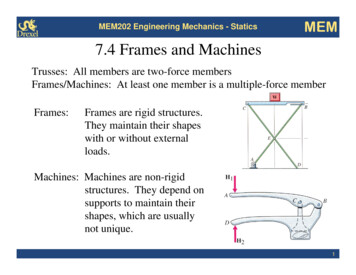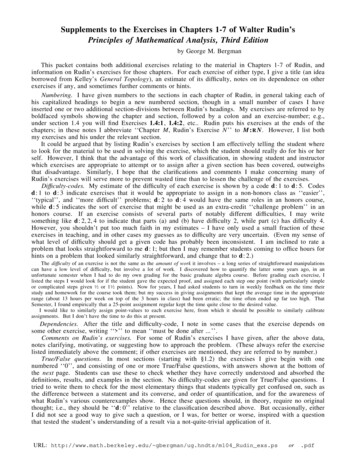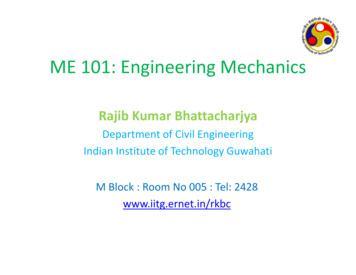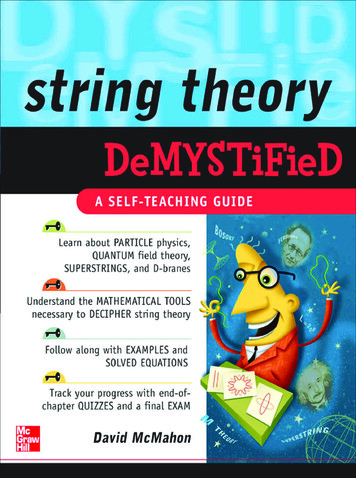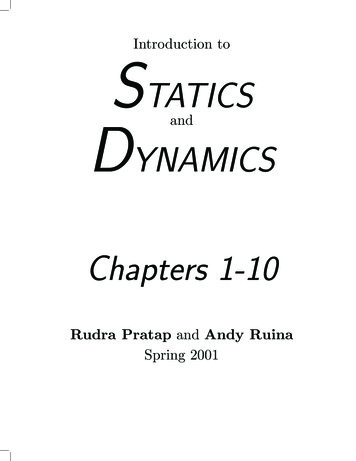
Transcription
Introduction toSTATICSDYNAMICSandChapters 1-10Rudra Pratap and Andy RuinaSpring 2001
c Rudra Pratap and Andy Ruina, 1994-2001. All rights reserved. No part of this book may be reproduced, stored in a retrieval system, or transmitted, inany form or by any means, electronic, mechanical, photocopying, or otherwise,without prior written permission of the authors.This book is a pre-release version of a book in progress for Oxford UniversityPress.The following are amongst those who have helped with this book as editors,artists, advisors, or critics: Alexa Barnes, Joseph Burns, Jason Cortell, IvanDobrianov, Gabor Domokos, Thu Dong, Gail Fish, John Gibson, Saptarsi Haldar, Dave Heimstra, Theresa Howley, Herbert Hui, Michael Marder, Elaina McCartney, Arthur Ogawa, Kalpana Pratap, Richard Rand, Dane Quinn, PhoebusRosakis, Les Schaeffer, David Shipman, Jill Startzell, Saskya van Nouhuys, BillZobrist. Mike Coleman worked extensively on the text, wrote many of the examples and homework problems and created many of the figures. David Hohas brought almost all of the artwork to its present state. Some of the homework problems are modifications from the Cornell’s Theoretical and AppliedMechanics archives and thus are due to T&AM faculty or their libraries in waysthat we do not know how to give proper attribution. Many unlisted friends,colleagues, relatives, students, and anonymous reviewers have also made helpfulsuggestions.Software used to prepare this book includes TeXtures, BLUESKY’s implementation of LaTeX, Adobe Illustrator and MATLAB.Most recent text modifications on January 21, 2001.
Summary of Mechanics0)The laws of mechanics apply to any collection of material or ‘body.’ This body could be the overall system of studyor any part of it. In the equations below, the forces and moments are those that show on a free body diagram. Interactingbodies cause equal and opposite forces and moments on each other.I)Linear Momentum Balance (LMB)/ForceXBalance** Equation of MotionFi LImpulse-momentum(integrating in time)Conservationof momentumP **(if F i 0 )Statics* is negligible)(if LZt2X**F i ·dt 1Lt1* *L0 ****1L L2 L1 0X **Fi 0II) Angular Momentum Balance (AMB)/MomentX *Balance*Equation of motionMC H CImpulse-momentum (angular)(integrating in time)Conservationof angular momentumP **(if MC 0)Statics*(if H C is negligible)Zt2Xt1***MC dt 1H C*MC 0III) Power Balance (1st law of thermodynamics)Equation of motionQ̇ P Ė K Ė P Ė int {z}ĖZt2for finite timet1ZQ̇dt t2(I)Net impulse is equal to the change inmomentum.(Ia)When there is no net force the linearmomentum does not change.(Ib)If the inertial terms are zero thenet force on system is zero.(Ic)The sum of moments is equal to the (II)rate of change of angular momentum.**H C 0 ****1H C H C2 H C1 0XThe total force on a body is equalto its rate of change of linearmomentum.Pdt 1Et1The net angular impulse is equal tothe change in angular momentum.(IIa)If there is no net moment about point (IIb)C then the angular momentum aboutpoint C does not change.If the inertial terms are zero then thetotal moment on the system is zero.(IIc)Heat flow plus mechanical powerinto a system is equal to its changein energy (kinetic potential internal).(III)The net energy flow going in is equalto the net change in energy.(IIIa)If no energy flows into a system,then its energy does not change.(IIIb)Conservation of Energy(if Q̇ P 0)Ė 0 1E E 2 E 1 0Statics(if Ė K is negligible)Q̇ P Ė P Ė intIf there is no change of kinetic energy (IIIc)then the change of potential andinternal energy is due to mechanicalwork and heat flow.Pure Mechanics(if heat flow and dissipationare negligible)P Ė K Ė PIn a system well modeled as purely(IIId)mechanical the change of kineticand potential energy is due to mechanicalwork.
Some Definitions(Please also look at the tables inside the back cover.)r*or*xPositionv* d r*dt(e.g., r*i r*i/O is the position of a pointi relative to the origin, O)Velocity*a d v*d 2 r* 2dtdt(e.g., v*i v*i/O is the velocity of a pointi relative to O, measured in a non-rotatingreference frame)Acceleration*ωα**L * L *HC * ω P m v*i i R v*dmdiscreteEK Angular velocityA measure of rotational velocity of a rigidbody.Angular accelerationA measure of rotational acceleration of arigid body.Linear momentumA measure of a system’s net translationalrate (weighted by mass).Rate of change of linearmomentumThe aspect of motion that balances the netforce on a system.Angularpoint CaboutA measure of the rotational rate of a system about a point C (weighted by massand distance from C).Rate of change of angular momentum about point CThe aspect of motion that balances the nettorque on a system about a point C.Kinetic energyA scalar measure of net system motion.Internal energyThe non-kinetic non-potential part of asystem’s total energy.Power of forces and torquesThe mechanical energy flow into a system. Also, P Ẇ , rate of work.Moment of inertia matrix aboutcmA measure of how mass is distributed ina rigid body.continuousm tot v*cm * Pmai i* R admdiscretecontinuous*m tot acm P r* m v*i ii/C R r* v*dmdiscretecontinuous/C*H C **(e.g., ai a i/O is the acceleration of apoint i relative to O, measured in a Newtonian frame) * P r* m ai i discretei/C* R r* admcontinuous/C 1 P m v 2 discretei i2 1 R v 2 dm continuousmomentum2E int P (heat-like terms)P [I cm ] *F i · v*i I xcmx cm Ix y I xcmzPI xcmycmI yycmI yz**M i ·ωiI xcmz cm I yz cmIzz
Contents1Mechanics1.1 What is mechanics . . . . . . . . . . . . . . . . . . . . . . . . . .2Vectors for mechanics2.1 Vector notation and vector addition . . . . . . . .2.2 The dot product of two vectors . . . . . . . . . . .2.3 Cross product, moment, and moment about an axis2.4 Equivalent force systems . . . . . . . . . . . . . .2.5 Center of mass and gravity . . . . . . . . . . . . .11.78243453623Free body diagrams3.1 Free body diagrams . . . . . . . . . . . . . . . . . . . . . . . . .77784Statics4.1 Static equilibrium of one body . . . . . . . . . . . . . . . . .4.2 Elementary truss analysis . . . . . . . . . . . . . . . . . . .4.3 Advanced truss analysis: determinacy, rigidity, and redundancy4.4 Internal forces . . . . . . . . . . . . . . . . . . . . . . . . .4.5 Springs . . . . . . . . . . . . . . . . . . . . . . . . . . . . .4.6 Structures and machines . . . . . . . . . . . . . . . . . . . .4.7 Hydrostatics . . . . . . . . . . . . . . . . . . . . . . . . . .4.8 Advanced statics . . . . . . . . . . . . . . . . . . . . . . . .105107129138146162179195206Dynamics of particles5.1 Force and motion in 1D . . . . . . . . . . . . . . . . . . . .5.2 Energy methods in 1D . . . . . . . . . . . . . . . . . . . . .5.3 The harmonic oscillator . . . . . . . . . . . . . . . . . . . .5.4 More on vibrations: damping . . . . . . . . . . . . . . . . .5.5 Forced oscillations and resonance . . . . . . . . . . . . . . .5.6 Coupled motions in 1D . . . . . . . . . . . . . . . . . . . . .5.7 Time derivative of a vector: position, velocity and acceleration5.8 Spatial dynamics of a particle . . . . . . . . . . . . . . . . .5.9 Central-force motion and celestial mechanics . . . . . . . . .5.10 Coupled motions of particles in space . . . . . . . . . . . . .21721923324025726427428128830231256.Constrained straight line motion3276.1 1-D constrained motion and pulleys . . . . . . . . . . . . . . . . . 3286.2 2-D and 3-D forces even though the motion is straight . . . . . . . . 339i
iiCONTENTS789Circular motion7.1 Kinematics of a particle in planar circular motion .7.2 Dynamics of a particle in circular motion . . . . .7.3 Kinematics of a rigid body in planar circular motion7.4 Dynamics of a rigid body in planar circular motioncm and I O . . . . . . . .7.5 Polar moment of inertia: Izzzzcm and I O in 2-D circular motion dynamics7.6 Using Izzzz.353354365372389404414Advanced topics in circular motion8.1 3-D description of circular motion . . . .8.2 Dynamics of fixed-axis rotation . . . . .8.3 Moment of inertia matrices [I cm ] and [I O ]8.4 Mechanics using [I cm ] and [I O ] . . . . .8.5 Dynamic balance . . . . . . . . . . . . .431432442455467489General planar motion of a rigid body9.1 Kinematics of planar rigid-body motion . . . . . . . . .9.2 Unconstrained dynamics of 2-D rigid-body planar motion9.3 Special topics in planar kinematics . . . . . . . . . . . .9.4 Mechanics of contacting bodies: rolling and sliding . . .9.5 Collisions . . . . . . . . . . . . . . . . . . . . . . . .497498508513526542.10 Kinematics using time-varying base vectors54710.1 Polar coordinates and path coordinates . . . . . . . . . . . . . . . . 54710.2 Rotating reference frames . . . . . . . . . . . . . . . . . . . . . . 55710.3 General expressions for velocity and acceleration . . . . . . . . . . 560
PrefaceThis is a statics and dynamics text for second or third year engineering students withan emphasis on vectors, free body diagrams, the basic momentum balance principles,and the utility of computation. Students often start a course like this thinking ofmechanics reasoning as being vague and complicated. Our aim is to replace thisloose thinking with concrete and simple mechanics problem-solving skills that liveharmoniously with a useful mechanical intuition.Knowledge of freshman calculus is assumed. Although most students have seenvector dot and cross products, vector topics are introduced from scratch in the contextof mechanics. The use of matrices (to tidily set up systems of equations) and ofdifferential equations (for describing motion in dynamics) are presented to the extentneeded. The set up of equations for computer solutions is presented in a pseudolanguage easily translated by the student into one or another computation packagethat the student knows.OrganizationWe have aimed here to better unify the subject, in part, by an improved organization.Mechanics can be subdivided in various ways: statics vs dynamics, particles vs rigidbodies, and 1 vs 2 vs 3 spatial dimensions. Thus a 12 chapter mechanics table ofcontents could look like thisII. DynamicsC. particles7) 1D8) 2D9) 3DD. rigid bodiesI. StaticsA. particles1) 1D2) 2D3) 3DB. rigid bodies4) 1D10) 1D5) 2D11) 2D6) 3D12) 3DHowever, these topics are far from equal in their difficulty or in the number of subtopicsthey contain. Further, there are various concepts and skills that are common to manyof the 12 sub-topics. Dividing mechanics into these bits distracts from the unity of thesubject. Although some vestiges of the scheme above remain, our book has evolvedto a different organization through trial and error, thought and rethought, review andrevision, and nine semesters of student testing.The first four chapters cover the basics of statics. Dynamics of particles andrigid bodies, based on progressively more difficult motions, is presented in chaptersfive to twelve. Relatively harder topics, that might be skipped in quicker courses,are identifiable by chapter, section or subsection titles containing words like “threedimensional” or “advanced”. In more detail:iiicomplexityof objectsrigidbodyparticlenumber ofdimensionsstaticdynamic1Dhow muchinertia2D3D
ivPREFACEChapter 1 defines mechanics as a subject which makes predictions about forces andmotions using models of mechanical behavior, geometry, and the basic balancelaws. The laws of mechanics are informally summarized.Chapter 2 introduces vector skills in the context of mechanics. Notational clarity isemphasized because correct calculation is impossible without distinguishingvectors from scalars. Vector addition is motivated by the need to add forces andrelative positions, dot products are motivated as the tool which reduces vectorequations to scalar equations, and cross products are motivated as the formulawhich correctly calculates the heuristically motivated concept of moment andmoment about an axis.Chapter 3 is about free body diagrams. It is a separate chapter because, in our experience,good use of free body diagrams is almost synonymous with correct mechanicsproblem solution. To emphasize this to students we recommend that, to getany credit for a problem that uses balance laws, a free body diagram must bedrawn.Chapter 4 makes up a short course in statics including an introduction to trusses, mechanisms, beams and hydrostatics. The emphasis is on two-dimensional problemsuntil the last, more advanced section. Solution methods that depend on kinematics (i.e., work methods) are deferred until the dynamics chapters. But forthe stretch of linear springs, deformations are not covered.Chapter 5 is about unconstrained motion of one or more particles. It shows how far**you can go using F m aand Cartesian coordinates in 1, 2 and 3 dimensionsin the absence of kinematic constraints. The first five sections are a thoroughintroduction to motion of one particle in one dimension, so called scalar physics,namely the equation F(x, v, t) ma. This involves review of freshmancalculus as well as an introduction to energy methods. A few special cases areemphasized, namely, constant acceleration, force dependent on position (thusmotivating energy methods), and the harmonic oscillator. After one section oncoupled motions in 1 dimension, sections seven to ten discuss motion in twoand three dimensions. The easy set up for computation of trajectories, withvarious force laws, and even with multiple particles, is emphasized. The chapterends with a mostly theoretical section on the center-of-mass simplifications forsystems of particles.Chapter 6 is the first chapter that concerns kinematic constraint in its simplest context,systems that are constrained to move without rotation in a straight line. Inone dimension pulley problems provide the main example. Two and threedimensional problems are covered, such as finding structural support forcesin accelerating vehicles and the slowing or incipient capsize of a braking car.Angular momentum balance is introduced as a needed tool but without theusual complexities of curvilinear motion.Chapter 7 treats pure rotation about a fixed axis in two dimensions. Polar coordinatesand base vectors are first used here in their simplest possible context. Theprimary applications are pendulums, gear trains, and rotationally acceleratingmotors or brakes.Chapter 8 extends chapter 7 to fixed axis rotation in three dimensions. The key newkinematic tool here is the non-trivial use of the cross product. Fixed axis rotationis the simplest motion with which one can introduce the full moment of inertiamatrix, where the diagonal terms are analogous to the scalar 2D moment ofinertia and the off-diagonal terms have a “centripetal” interpretation. The mainnew application is dynamic balance.Chapter 9 treats general planar motion of a (planar) rigid body including rolling, slidingand free flight. Multi-body systems are also considered so long as they donot involve constraint (i.e., collisions and spring connections but not hinges orprismatic joints).
PREFACEChapter 10 is entirely about kinematics of particle motion. The over-riding theme is theuse of base vectors which change with time. First, the discussion of polar coordinates started in chapter 7 is completed. Then path coordinates are introduced.The kinematics of relative motion, a topic that many students find difficult, istreated carefully but not elaborately in two stages. First using rotating basevectors connected to a moving rigid body and then using the more abstractnotation associated with the famous “five term acceleration formula.”Chapter 11 is about the mechanics of 2D mechanisms using the kinematics from chapter10.Chapter 12 pushes some of the contents of chapter 9 into three dimensions. In particular,the three dimensional motion of a single rigid body is covered. Rather thanemphasize the few problems that are amenable to pencil and paper solution,emphasis is on the basic principles and on the setup for numerical solution.Chapter 13 on contact laws (friction, collisions, and rolling) will probably serve only asa reference for most courses. Because elementary reference material on thesetopics is so lacking, these topics are covered here with more depth than can befound in any modern text at any level.Chapter 14 on units and dimensions is placed at the end for reference. Because studentsare immune to preaching about units out of context, such as in an early or latechapter like this one, the main messages are presented by example throughoutthe book:– All engineering calculations using dimensional quantities must be dimensionally ‘balanced’.– Units are ‘carried’ from one line of calculation to the next by the samerules as go numbers and variables.A leisurely one semester statics course, or a more fast-paced half semester prelude tostrength of materials should use chapters 1-4. A typical one semester dynamics courseshould cover about two thirds of chapters 5-12 preceded by topics from chapters 1-4,as needed. A one semester statics and dynamics course should cover about two thirdsof chapters 1-6 and 8. A full year statics and dynamics course should cover most ofthe book.Organization and formattingEach subject is covered in various ways. Every section starts with descriptive text and short examples motivating anddescribing the theory; More detailed explanations of the theory are in boxes interspersed in the text.For example, one box explains the common derivation of angular momentumbalance form linear momentum balance, one explains the genius of the wheel,*and another connects ωbased kinematics to êr and êθ based kinematics; Sample problems (marked with a gray border) at the end of most sectionsshow how to do homework-like calculations. These are meticulous in theiruse of free body diagrams, systematic application of basic principles, vectornotation, units, and checks against intuition and special cases; Homework problems at the end of each chapter give students a chance topractice mechanics calculations. The first problems for each section build astudent’s confidence with the basic ideas. The problems are ranked in approximate order of difficulty, with theoretical questions last. Problems marked withan * have an answer at the back of the book;v
viPREFACE Reference tables on the inside covers and end pages concisely summarizemuch of the content in the book. These tables can save students the time ofhunting for formulas and definitions. They also serve to visibly demonstratethe basically simple structure of the whole subject of mechanics.NotationClear vector notation helps students do problems. Students sometimes mistakenlytranscribe a conventionally printed bold vector F the same way they transcribe aplain-text scalar F. To help minimize this error we use a redundant vector notation*in this book (bold and harpooned F ).As for all authors and teachers concerned with motion in two and three dimensions we have struggled with the tradeoffs between a precise notation and a simplenotation. Beautifully clear notations are intimidating. Perfectly simple notations areambiguous. Our attempt to find clarity without clutter is summarized in the box onpage 9.Relation to other mechanics books1 One near-classic that we have especiallyenjoyed is J.P. Den Hartog’s Mechanicsoriginally published in 1948 but still available as an inexpensive reprint.This book is in some ways original in organization and approach. It also containssome important but not sufficiently well known concepts, for example that angularmomentum balance applies relative to any point, not just an arcane list of points. Butthere is little mechanics here that cannot be found in other books, including freshmanphysics texts, other engineering texts, and hundreds of classics.Mastery of freshman physics (e.g., from Halliday & Resnick, Tipler, or Serway)would encompass some part of this book’s contents. However freshman physicsgenerally leaves students with a vague notion of what mechanics is, and how it canbe used. For example many students leave freshman physics with the sense that afree body diagram (or ‘force diagram’) is an vague conceptual picture with arrowsfor various forces and motions drawn on it this way and that. Even the book picturessometimes do not make clear what force is acting on what body. Also, becausefreshman physics tends to avoid use of college math, many students end up with nosense of how to use vectors or calculus to solve mechanics problems. This book aimsto lead students who may start with these fuzzy freshman physics notions into a worldof intuitive yet precise mechanics.There are many statics and dynamics textbooks which cover about the samematerial as this one. These textbooks have modern applications, ample samples, lotsof pictures, and lots of homework problems. Many are good (or even excellent) intheir own ways. Most of today’s engineering professors learned from one of thesebooks. We wrote this book because the other books do not adequately convey thesimple network of ideas that makes up the whole of Newtonian mechanics. We intendthat through this book book students will come to see not mechanics as a coherentnetwork of basic ideas rather than a collection of ad-hoc recipes and tricks that oneneed memorize or hope to discover by divine inspiration.There are hundreds of older books with titles like statics, engineering mechanics, dynamics, machines, mechanisms, kinematics, or elementary physics that coveraspects of the material here 1 Although many mechanics books written from 16891960, are amazingly thoughtful and complete, none are good modern textbooks. Theylack an appropriate pace, style of speech, and organization. They are too reliant ongeometry skills and not enough on vectors and numerical computation skills. Theylack sufficient modern applications, sample calculations, illustrations, and homeworkproblems for a modern text book.
PREFACEviiThank youWe have attempted to write a book which will help make the teaching and learning ofmechanics more fun and more effective. We have tried to present the truth as we knowit and as we think it is most effectively communicated. But we have undoubtedly leftvarious technical and strategic errors. We thank you in advance for letting us knowyour thoughts.Rudra Pratap, rp28@cornell.eduAndy Ruina, ruina@cornell.edu
viiiPREFACETo the studentMother nature is so strict that, to the extent we know her rules, we can make reliablepredictions about the behavior of her children, the world of physical objects. Inparticular, for essentially all practical purposes all objects that engineers study strictlyfollow the laws of Newtonian mechanics. So, if you learn the laws of mechanics,as this book should help you do, you will gain intuition about how the world worksand you will be able to make quantitative calculations that predict how things stand,move, and fall.How to use this bookMost of you will naturally get help with homework by looking at similar examplesand samples in the text or lecture notes, by looking up formulas in the front and backcovers, or by asking questions of friends, teaching assistants and professors. Whatgood are books, notes, classmates or teachers if they don’t help you do homeworkproblems? All the examples and sample problems in this book, for example, arejust for this purpose. But too-much use of these resources while solving problemscan lead to self deception. To see if you have learned to do a problem, do it again,justifying each step, without looking up even one small thing. If you can’t do this,you have a new opportunity to learn at two levels. First, you can learn the missingskill or idea. More deeply, by getting stuck after you have been able to get through aproblem with guidance, you can learn things about your learning process. Often thereal source of difficulty isn’t a key formula or fact, but something more subtle. Wehave tried to bring out some of these more subtle ideas in the text discussions whichwe hope you read, sooner or later.Some of you are science and math school-smart, mechanically inclined, or areespecially motivated to learn mechanics. Others of you are reluctantly taking thisclass to fulfil a requirement. We have written this book with both of you in mind.The sections start with generally accessible introductory material and include simpleexamples. The early sample problems in each section are also easy. But we alsohave discussions of the theory and other more advanced asides to challenge moremotivated students.Calculation strategies and skillsWe try here to show you a systematic approach to solving problems. But it is notpossible to reduce the world of mechanics problem solutions to one clear set ofsteps to follow. There is an art to solving problems, whether homework problems orengineering design problems. Art and human insight, as opposed to precise algorithmor recipe, is what makes engineering require humans and not just computers. Throughdiscussion and examples, we will try to teach you some of this systematic art. Hereare a few general guidelines that apply to many problems.
PREFACEUnderstand the questionYou may be tempted to start writing equations and quoting principles when you firstsee a problem. But it is generally worth a few minutes (and sometimes a few hours)to try to get an intuitive sense of a problem before jumping to equations. Before youdraw any sketches or write equations, think: does the problem make sense? Whatinformation has been given? What are you trying to find? Is what you are trying tofind determined by what is given? What physical laws make the problem solvable?What extra information do you think you need? What information have you beengiven that you don’t need? Your general sense of the problem will steer you throughthe technical details.Some students find they can read every line of sample problems yet cannot dotest problems, or, later on, cannot do applied design work effectively. This failingmay come from following details without spending time, thinking, gaining an overallsense of the problems.Think through your solution strategyFor the problem solutions we present in this book or in class, there was a time whenwe had to think about the order of our work. You also have to think about the orderof your work. You will find some tips in the text and samples. But it is your job toown the material, to learn how to think about it your own way, to become an expertin your own style, and to do the work in the way that makes things most clear to youand your readers.What’s in your toolbox?In the toolbox of someone who can solve lots of mechanics problems are two wellworn tools: A vector calculator that always keeps vectors and scalars distinct, and A reliable and clear free body diagram drawing tool.Because many of the terms in mechanics equations are vectors, the ability to do vectorcalculations is essential. Because the concept of an isolated system is at the core ofmechanics, every mechanics practitioner needs the ability to draw a good free bodydiagram. Would that we could write“Click on WWW.MECH.TOOL today and order your own professionalvector calculator and expert free body diagram drawing tool!”,but we can’t. After we informally introduce mechanics in the first chapter, the secondand third chapters help you build your own set of these two most-important tools.Guarantee: if you learn to do clear correct vector algebra and to draw goodfree body diagrams you will do well at mechanics.Think hardWe do mechanics because we like mechanics. We get pleasure from thinking abouthow things work, and satisfaction from doing calculations that make realistic predictions. Our hope is that you also will enjoy idly thinking about mechanics and thatyou will be proud of your new modeling and calculation skills. You will get thereif you think hard. And you will get there more easily if you learn to enjoy thinkinghard. Often the best places to study are away from books, notes, pencil or paper.ix
xPREFACEA note on computationMechanics is a physical subject. The concepts in mechanics do not depend on computers. But mechanics is also a quantitative and applied subject described with numbers.Computers are very good with numbers. Thus the modern practice of engineeringmechanics depends on computers. The most-needed computer skills for mechanicsare: solution of simultaneous algebraic equations, plotting, and numerical solution of ODEs.More basically, an engineer also needs the ability to routinely evaluate standardfunctions (x 3 , cos 1 θ , etc.), to enter and manipulate lists and arrays of numbers, andto write short programs.Classical languages, applied packages, and simulatorsProgramming in standard languages such as Fortran, Basic, C, Pascal, or Java probably take too much time to use in solving simple mechanics problems. Thus anengineer needs to learn to use one or another widely available computational package(e.g., MATLAB, OCTAVE, MAPLE, MATHEMATICA, MATHCAD, TKSOLVER,LABVIEW, etc). We assume that students have learned, or are learning such a package. We also encourage the use of packaged mechanics simulators (e.g., WORKINGMODEL, ADAMS, DADS, etc) for building intuition, but none of the homework heredepends on access to such a packaged simulator.How we explain computation in this book.Solving a mechanics problem involves these major steps(a) Reducing a physical problem to a well posed mathematical problem;(b) Solving the math problem using some combination of pencil and paper andnumerical computation; and(c) Giving physical interpretation of the mathematical solution.This book is primarily about setup (a) and interpretation (c), which are the same, nomatter what method is used to solve the equations. If a problem require
Jan 21, 2001 · Summary of Mechanics 0) The laws of mechanics apply to any collection of material or ‘body.’This body could be the overall system of study or any part of it. In the equations below, the forces and moments are those that show on a free body diagram. Interacting bodies c



